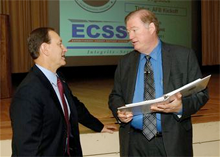
Ross Marshall, left, Oklahoma City Air Logistics Center Executive Director, and Don Pugh from Air Force Materiel Command Headquarters, at the kickoff meeting for the Expeditionary Combat Support System (ECSS) at Tinker Air Force Base, in Oklahoma, on August 17, 2011. ECSS, an Enterprise Resource Planning system conceived at the turn of the century, was to be operational by 2012. But it was cancelled in November, 2012, after consuming USD 1 billion, even though its objectives had been reduced to 25% of the original concept, and its delivery date had been extended to 2020.
According to Brig. Gen. Kathryn Johnson, the Air Force's director of system integration, and Robert Shofner, the Air Force's program executive officer for business and enterprise systems, one of the problems was that Computer Sciences Corp. (CSC) of Falls Church, Virginia, the prime contractor, was not able to adapt the Oracle software to meet the system requirements. CSC, which had been fired in March 2012, was thus being blamed in absentia for at least part of the failure of the project.
Air Force photo by Margo Wright.
When projects founder, their leaders, sponsors, and champions sometimes experience the foundering personally. Even if they don't experience the failure as personal, their experience of how others see the failure can have similar effects. When this happens, an overwhelming urge to repair the failure can develop. If repairs succeed, both organizational and personal needs are fulfilled. But when repair is impossible, things get more interesting.
In such cases, the project's leaders have already exhausted the obvious solutions: trying other approaches, or asking for more budget or time. They must therefore resolve the tension between the initially promised objectives and the current disappointing reality by means other than delivering what was promised, because that's plainly impossible.
Recognizing the techniques they use in such quandaries is helpful to both members of the project team, and the supervisors of the project's leaders, sponsors, and champions. Here are some techniques in common use.
- Confessing failure
- Confession is almost certainly the only honest approach. It's always available, but because, in most organizations, it presents significant risk to one's career, there is a tendency to avoid confession.
- Expanding
- Expanding the project's objectives can both conceal the failure and justify additional budget and schedule. Expansion in this form can be a cause of scope creep. See "Some Causes of Scope Creep," Point Lookout for September 4, 2002, for more.
- Fleeing the scene
- Flight, usually without admitting failure, works well if its true motivation can remain concealed long enough. It can take the form of promotion, transfer to another project or business unit, or "accepting new challenges" elsewhere.
- Embellishing
- Embellishing, or "spinning," is a technique for representing in a misleadingly positive way the results that actually were achieved. If successful, embellishing buys time — at best.
- Declaring victory
- The extreme form of embellishment is announcing that the effort's primary objectives have been achieved and we're now ready to focus our energies on the next challenge. Since everyone knows the current effort is a disappointment, this announcement is rarely questioned overtly.
- Blowing smoke
- Blowing smoke, Embellishing, or "spinning," is
a technique for representing
in a misleadingly positive
way the results that were
actually achievedor obfuscating, can confuse decision makers and team members alike. Making others believe that the effort is going better than it seems to be is usually just another delay tactic. - Misrepresenting status fraudulently
- Outright lying is always possible, but because the risk of exposure is ordinarily so high, and the consequences so severe, this method is most practical for those who work in very secure or highly compartmentalized environments, where "knowledge firewalls" limit the chances of exposure.
- Blaming
- Placing responsibility for the project's troubles at the feet of the defenseless is a useful technique, because it so clearly absolves those who are doing the blaming. Defenseless individuals include those who have already departed the organization and those whose credibility is already so eroded — sometimes unjustly — that they cannot refute the claims made against them.
Do you know of a project in trouble? How many of these tactics have you seen? ![]() Top
Top ![]() Next Issue
Next Issue
Is every other day a tense, anxious, angry misery as you watch people around you, who couldn't even think their way through a game of Jacks, win at workplace politics and steal the credit and glory for just about everyone's best work including yours? Read 303 Secrets of Workplace Politics, filled with tips and techniques for succeeding in workplace politics. More info
Your comments are welcome
Would you like to see your comments posted here? rbrenaXXxGCwVgbgLZDuRner@ChacDjdMAATPdDNJnrSwoCanyon.comSend me your comments by email, or by Web form.About Point Lookout
 Thank you for reading this article. I hope you enjoyed it and
found it useful, and that you'll consider recommending it to a friend.
Thank you for reading this article. I hope you enjoyed it and
found it useful, and that you'll consider recommending it to a friend.
This article in its entirety was written by a human being. No machine intelligence was involved in any way.
Point Lookout is a free weekly email newsletter. Browse the archive of past issues. Subscribe for free.
Support Point Lookout by joining the Friends of Point Lookout, as an individual or as an organization.
Do you face a complex interpersonal situation? Send it in, anonymously if you like, and I'll give you my two cents.
Related articles
More articles on Project Management:
 Nine Positive Indicators of Negative Progress
Nine Positive Indicators of Negative Progress- Project status reports rarely acknowledge negative progress until after it becomes undeniable. But projects
do sometimes move backwards, outside of our awareness. What are the warning signs that negative progress
might be underway?
 Backtracking in Incremental Problem Solving
Backtracking in Incremental Problem Solving- Incremental problem solving is fashionable these days. Whether called evolutionary, incremental, or
iterative, the approach entails unique risks. Managing those risks sometimes requires counterintuitive action.
 Planning Disappointments
Planning Disappointments- When we plan projects, we make estimates of total costs and expected delivery dates. Often these estimates
are so wrong — in the wrong direction — that we might as well be planning disappointments.
Why is this?
 Power Distance and Teams
Power Distance and Teams- One of the attributes of team cultures is something called power distance, which is a measure
of the overall comfort people have with inequality in the distribution of power. Power distance can
determine how well a team performs when executing high-risk projects.
 Anticipating Absence: How
Anticipating Absence: How- Knowledge workers are professionals who "think for a living." When they suddenly become unavailable
because of the pandemic, we consider substituting someone else. But substitutes need much more than
skills and experience to succeed.
See also Project Management for more related articles.
Forthcoming issues of Point Lookout
 Coming October 1: On the Risks of Obscuring Ignorance
Coming October 1: On the Risks of Obscuring Ignorance- A common dilemma in knowledge-based organizations: ask for an explanation, or "fake it" until you can somehow figure it out. The choice between admitting your own ignorance or obscuring it can be a difficult one. It has consequences for both the choice-maker and the organization. Available here and by RSS on October 1.
 And on October 8: Responding to Workplace Bullying
And on October 8: Responding to Workplace Bullying- Effective responses to bullying sometimes include "pushback tactics" that can deter perpetrators from further bullying. Because perpetrators use some of these same tactics, some people have difficulty employing them. But the need is real. Pushing back works. Available here and by RSS on October 8.
Coaching services
I offer email and telephone coaching at both corporate and individual rates. Contact Rick for details at rbrenaXXxGCwVgbgLZDuRner@ChacDjdMAATPdDNJnrSwoCanyon.com or (650) 787-6475, or toll-free in the continental US at (866) 378-5470.
Get the ebook!
Past issues of Point Lookout are available in six ebooks:
- Get 2001-2 in Geese Don't Land on Twigs (PDF, )
- Get 2003-4 in Why Dogs Wag (PDF, )
- Get 2005-6 in Loopy Things We Do (PDF, )
- Get 2007-8 in Things We Believe That Maybe Aren't So True (PDF, )
- Get 2009-10 in The Questions Not Asked (PDF, )
- Get all of the first twelve years (2001-2012) in The Collected Issues of Point Lookout (PDF, )
Are you a writer, editor or publisher on deadline? Are you looking for an article that will get people talking and get compliments flying your way? You can have 500-1000 words in your inbox in one hour. License any article from this Web site. More info
Follow Rick
Recommend this issue to a friend
Send an email message to a friend
rbrenaXXxGCwVgbgLZDuRner@ChacDjdMAATPdDNJnrSwoCanyon.comSend a message to Rick
![]() A Tip A Day feed
A Tip A Day feed
![]() Point Lookout weekly feed
Point Lookout weekly feed
 My blog, Technical Debt for Policymakers, offers
resources, insights, and conversations of interest to policymakers who are concerned with managing
technical debt within their organizations. Get the millstone of technical debt off the neck of your
organization!
My blog, Technical Debt for Policymakers, offers
resources, insights, and conversations of interest to policymakers who are concerned with managing
technical debt within their organizations. Get the millstone of technical debt off the neck of your
organization!